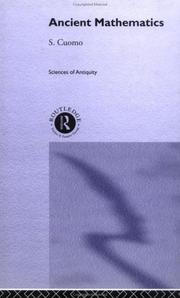| Listing 1 - 10 of 87 | << page >> |
Sort by
|
Book
Year: 1962 Publisher: Leipzig : Teubner,
Abstract | Keywords | Export | Availability | Bookmark
 Loading...
Loading...Choose an application
- Reference Manager
- EndNote
- RefWorks (Direct export to RefWorks)
Book
Year: 1990 Publisher: Portland T. Nag
Abstract | Keywords | Export | Availability | Bookmark
 Loading...
Loading...Choose an application
- Reference Manager
- EndNote
- RefWorks (Direct export to RefWorks)

ISBN: 9780203995730 9780415164948 9780415164955 Year: 2001 Publisher: London Routledge
Abstract | Keywords | Export | Availability | Bookmark
 Loading...
Loading...Choose an application
- Reference Manager
- EndNote
- RefWorks (Direct export to RefWorks)
The theorem of Pythagoras, Euclid's ""Elements"", Archimedes' method to find the volume of a sphere: all parts of the invaluable legacy of ancient mathematics. But ancient mathematics was also about counting and measuring, surveying land and attributing mystical significance to the number six. This volume offers the first accessible survey of the discipline in all its variety and diversity of practices. The period covered ranges from the fifth century BC to the sixth century AD, with the focus on the Mediterranean region. Topics include:* mathematics and politics in classical Greece
Book
Year: 1992
Abstract | Keywords | Export | Availability | Bookmark
 Loading...
Loading...Choose an application
- Reference Manager
- EndNote
- RefWorks (Direct export to RefWorks)
Book
ISBN: 9798765619445 Year: 2024 Publisher: Minneapolis : Lerner Publishing Group,
Abstract | Keywords | Export | Availability | Bookmark
 Loading...
Loading...Choose an application
- Reference Manager
- EndNote
- RefWorks (Direct export to RefWorks)
This book explores the history and evolution of computing from ancient times to the modern era. It examines how early civilizations used mathematics and basic computation tools like tally sticks and bones to measure time, navigate the seas, and solve complex problems without the aid of modern technology. The work delves into the contributions of different cultures, including the Greeks, Egyptians, and Babylonians, highlighting their advancements in arithmetic, algebra, and geometry. It traces the journey from primitive methods to the digital age, illustrating how foundational ancient techniques have influenced contemporary computational devices. Aimed at readers interested in the history of technology and mathematics, the book provides a comprehensive overview of how computing has been integral to human progress.
Computers --- Mathematics, Ancient. --- History. --- Mathematics, Ancient --- History
Book
ISBN: 2862720216 9782862720210 Year: 1992 Volume: 11 Publisher: Saint-Etienne: Publications de l'Université de Saint-Étienne,
Abstract | Keywords | Export | Availability | Bookmark
 Loading...
Loading...Choose an application
- Reference Manager
- EndNote
- RefWorks (Direct export to RefWorks)
Book
ISBN: 0691194238 Year: 2019 Publisher: Princeton, NJ : Princeton University Press,
Abstract | Keywords | Export | Availability | Bookmark
 Loading...
Loading...Choose an application
- Reference Manager
- EndNote
- RefWorks (Direct export to RefWorks)
A comprehensive look at four of the most famous problems in mathematicsTales of Impossibility recounts the intriguing story of the renowned problems of antiquity, four of the most famous and studied questions in the history of mathematics. First posed by the ancient Greeks, these compass and straightedge problems-squaring the circle, trisecting an angle, doubling the cube, and inscribing regular polygons in a circle-have served as ever-present muses for mathematicians for more than two millennia. David Richeson follows the trail of these problems to show that ultimately their proofs-demonstrating the impossibility of solving them using only a compass and straightedge-depended on and resulted in the growth of mathematics.Richeson investigates how celebrated luminaries, including Euclid, Archimedes, Viète, Descartes, Newton, and Gauss, labored to understand these problems and how many major mathematical discoveries were related to their explorations. Although the problems were based in geometry, their resolutions were not, and had to wait until the nineteenth century, when mathematicians had developed the theory of real and complex numbers, analytic geometry, algebra, and calculus. Pierre Wantzel, a little-known mathematician, and Ferdinand von Lindemann, through his work on pi, finally determined the problems were impossible to solve. Along the way, Richeson provides entertaining anecdotes connected to the problems, such as how the Indiana state legislature passed a bill setting an incorrect value for pi and how Leonardo da Vinci made elegant contributions in his own study of these problems.Taking readers from the classical period to the present, Tales of Impossibility chronicles how four unsolvable problems have captivated mathematical thinking for centuries.
Book
ISBN: 0883859289 9780883859285 Year: 2012 Publisher: Cambridge Cambridge University Press
Abstract | Keywords | Export | Availability | Bookmark
 Loading...
Loading...Choose an application
- Reference Manager
- EndNote
- RefWorks (Direct export to RefWorks)
Among other things, Aaboe shows us how the Babylonians did calculations, how Euclid proved that there are infinitely many primes, how Ptolemy constructed a trigonometric table in his Almagest, and how Archimedes trisected the angle. Some of the topics may be familiar to the reader, while others will seem surprising or be new.
Mathematics --- History. --- Mathematics, Ancient.
Book
ISBN: 3447042907 Year: 2000 Publisher: Wiesbaden Harrassowitz
Abstract | Keywords | Export | Availability | Bookmark
 Loading...
Loading...Choose an application
- Reference Manager
- EndNote
- RefWorks (Direct export to RefWorks)
Book
Year: 1914 Publisher: Lipsiae : In aedibus B. G. Teubneri,
Abstract | Keywords | Export | Availability | Bookmark
 Loading...
Loading...Choose an application
- Reference Manager
- EndNote
- RefWorks (Direct export to RefWorks)
| Listing 1 - 10 of 87 | << page >> |
Sort by
|

 Search
Search Feedback
Feedback About UniCat
About UniCat  Help
Help News
News